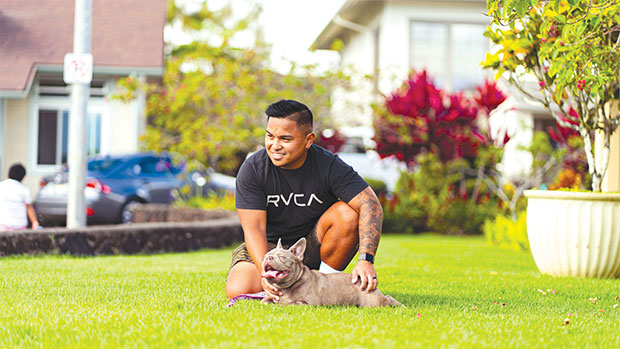A dethatching guide
Now that spring is just around the corner, many island homeowners have begun thinking about prepping their lawns for warm weather.
“Over the winter, the grass on some lawns gets thick and spongy,” says Sean Fong, owner of Hawaiian Turfgrass. “With warm weather on the horizon,it’s important to get it back into shape for summertime. A lot of yards are going to need some dethatching.”
Thatch is a layer of dead and decomposing plant matter that forms above the soil.
“When it’s just a thin layer, it can actually protect plant crowns and reduce compaction,” Fong says. “But when that layer gets too thick, nutrients and air can’t penetrate to the soil and roots.”
Thatch often occurs on heavily fertilized turf, explains Fong, or on lawns that haven’t been mowed regularly.
“We see it all the time in yards with poor drainage, or that have compacted, acidic soil,” he adds.
Dethatching a lawn takes a little time and effort, and should be done when the weather is consistently sunny. Here, Fong shares his tips for this important chore.
A BRIEF GUIDE TO DETHATCHING
“The dethatching process actually involves three steps: scalping, dethatching and sanding,” says Fong. “For the first step — scalping — you should mow your lawn thoroughly several times,lowering the blade height each time.”
After scalping, it’s time to use a dethatcher (also known as a scarifier), a landscaping tool that cuts through soil.
“A hand rake may work for very small areas, although it’s less effective at removing thatch, and it’s also very time-consuming,” Fong says.
Dethatcher blades should be set at an appropriate height, he cautions.
“It’s better to set them too high than too low. They can cause damage to the roots of your grass if set to an improper height.”
The scalping process cuts everything down, and dethatching removes dead roots and leaves. After the grass is mown almost to bare dirt, the next step is topdressing the turf with clean sand.
“That sandy layer creates a level surface, almost like a putting green,” explains Fong. “The grass will grow back through the sand.”
After dethatching is complete, Fong recommends applying fertilizer like MiracleGro® or Scotts® Turf-Builder® Southern Lawn Food.
“When you’re done dethatching and fertilizing, mow every one or two weeks with a reel mower set to a low height,” he concludes. “Do that throughout the summer and you should have a healthy, good-looking lawn.”
Hawaiian Turfgrass offers complete turnkey lawn services: site prep, irrigation, delivery and installation. Call 808-371-0527 and order your new lawn (minimum 400 square feet) by April 30 for a $500 installation discount! Prefer to install your new lawn yourself? Visit hawaiianturfgrass.com to place your order and arrange for pickup or curbside delivery!
HAWAIIAN TURFGRASS
BY APPOINTMENT ONLY
CONTACT 808-371-0527
ADDRESS 94-840 Lanikuhana Ave., Mililani
WEB hawaiianturfgrass.com


